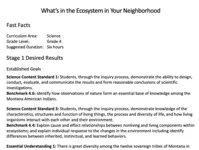What's in the Ecosystem in Your Neighborhood
https://opi.mt.gov/Portals/182/Page%20Files/Indian%20Education/Science/Neighborhood_Ecosystem%20-%20G4.pdf
https://opi.mt.gov/Portals/182/Page%20Files/Indian%20Education/Science/Neighborhood_Ecosystem%20-%20G4.pdf
Indian Education for All Montana Office of Public Instruction
This is a 6 part activity where students explore the connections between living and nonliving things in the ecosystem. Students will learn that an ecosystem is made up of groups of living things and the environment they live in, the living and nonliving parts of the ecosystem interact with one another, and that nature observations used by Montana Indians form an essential base of knowledge.
This learning activity takes six hours.
Learn more about Teaching Climate Literacy and Energy Awareness»Grade Level
Regional Focus
Online Readiness
Topics
Energy Literacy
This Activity builds on the following concepts of Energy Literacy.
Click a topic below for supporting information, teaching ideas, and sample activities.
Notes From Our Reviewers
The CLEAN collection is hand-picked and rigorously reviewed for scientific accuracy and classroom effectiveness.
Read what our review team had to say about this resource below or learn more about
how CLEAN reviews teaching materials
Teaching Tips | Science | Pedagogy |
Technical Details
Teaching Tips
- The assessment/evaluation includes a point system to grade students' work, so teachers might consider additional ways to explore evaluation as well.
About the Content
- This resource explains cause and effect relationships between nonliving and living components within ecosystems, and explains individual responses to changes in the environment including identify differences between inherited, instinctual, and learned behaviors.
- The data in this resource is collected by the students themselves through field trip to natural areas. A directory for tribal groups in Montana is offered as part of a resource, which would be useful if the lesson was being taught in Montana.
- The list of references at the end of the resource are books that are relevant to teach the lesson.
- Included are different performance tasks that revisit ideas leading to engagement in the activity, with background materials readily available.
- This lesson celebrates the indigenous ecological knowledge of local native people.
- Passed initial science review - expert science review pending.
About the Pedagogy
- This resource is complete and ready to use, it is divided between 6 days with specific lessons and teaching tips for each day, although there is not a separate teacher's guide.
- The lessons entail several student projects which involve multiple field trip outdoors 1) a field observation to draw an ecosystem, 2) a walking field trip to write down observations, 3) ecosystem walk 4) ecosystem interaction.
- The lessons incorporate several stories and a game that uses engaging questions about living, non-living organisms, what is an ecosystem using rocks to help understand the concept of how to observe an ecosystem.
- The lesson provides many engaging questions such as ones about living and non-living organisms and what is an ecosystem?
- Learning outcomes are clearly defined. Teacher guide and sequencing leads to long term project and lesson plans that follow each other in a beneficial way.
- This resource engages students in using scientific data.
See other data-rich activities








